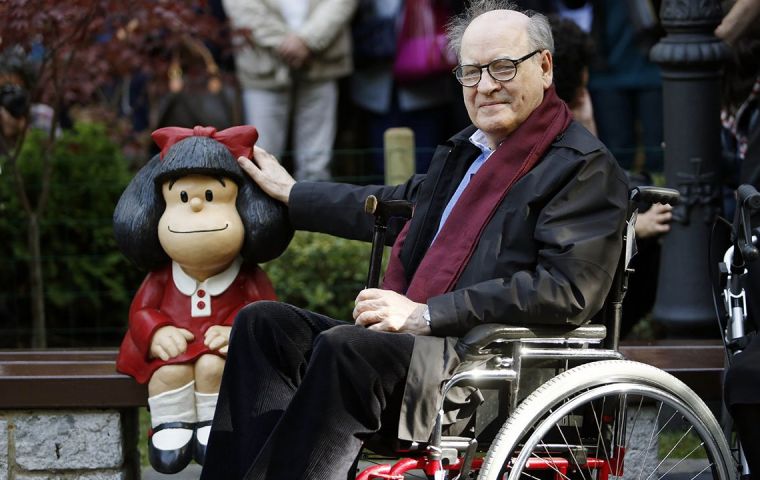MercoPress. South Atlantic News Agency
Quino, Argentine creator of the iconic comic strip Mafalda dies at the age of 88
 Although his vision was influenced by Argentina's political turmoil, the topics that he tackled were universal, and were translated to over 30 languages
Although his vision was influenced by Argentina's political turmoil, the topics that he tackled were universal, and were translated to over 30 languages Quino, the creator of the comic strip Mafalda (1964 to 1973) passed away from natural cause on Sept. 30 at the age of 88. He was born in Mendoza, Argentina in 1932 as Joaquín Salvador Lavado Tejón, son of Spanish immigrants, and trained as an illustrator first by his uncle and then by a brief stint at the Fine Arts College of Mendoza.
“Quino died. All the good people in the country and the world will mourn him,” said Daniel Divinsky, his long-time editor, on Twitter.
Quino got his big break in 1965. The newspaper El Mundo started to publish his comic strip Mafalda, which became incredibly popular across Latin America and Europe.
Mafalda featured a little Argentine girl from a middle-class Buenos Aires family with a keen sense of justice, a good eye for social and political hypocrisies and a mordant sense of humor. Quino pitched her as a mixture of Peanuts and Blondie, and although she was first conceived in 1962 as a publicity character to advertise Mansfield products, her quick wit charmed the editors of Primera Plana, El Mundo and Siete Dias Ilustrados, a weekly magazine.
After 1973, Quino only brought back Mafalda to promote humanitarian projects (mostly UNICEF), and focused on illustrated albums like Quinoterapia (Quinotherapy), where he broke down in comic book format the structural and personal elements that allowed inequality to persist all over the world, either with ad-absurdum of liberal concepts or by leaning into surrealist imagery -- like the police shooting down protestors with Valium.
Quino's humor was defined by his acid commentary on politics and the small annoyances of repressive states -- stagnant bureaucracy, authoritarian errors, police repression, poverty and close-mindedness, with a lot of compassion for the victims of these situations, as flawed as they might be.
Quino was able to use Mafalda's apparent innocence to spread scathing criticism of the dictatorships that plagued Latin America from the sixties, including Argentina's 1966/73 and 1976/1983 military dictatorships.
After a failed coup in 1987 against democratically elected president Raul Alfonsin, Quino published a cartoon with Mafalda saying, “yes to democracy! Yes to justice! Yes to freedom! Yes to life!”
Although his vision was influenced by Argentina's political turmoil in the 20th century, the topics that he tackled were universal -- he was very well known in Europe and Latin America, and his work was translated to over 30 languages. Mafalda has two statues -- one in San Telmo, Argentina, and another in Oviedo, Spain, one passageway in Angoulême, the Mecca of European comic, and a street in Gatineau, Canada.




Top Comments
Disclaimer & comment rulesCommenting for this story is now closed.
If you have a Facebook account, become a fan and comment on our Facebook Page!